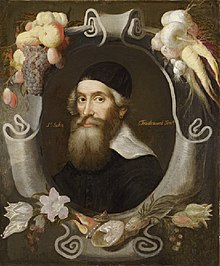John Tradescant the Elder
John Tradescant the Elder (baptized 1570 ; † April 15 or 16, 1638 in South Lambeth ) was an English gardener and botanist . His son was John Tradescant the younger .
Live and act
The origin of John Tradescan the Elder is not completely clear. Older lexicons indicate that he came from the Netherlands. Today, however, it is believed that he was born in Suffolk , England . There is evidence that he acquired his later good reputation as a gardener before 1600 with William Brooke, the 10th Baron of Cobham at his seat at Cobham Hall .
In 1609 Robert Cecil, the 1st Earl of Salisbury , hired him as a gardener for Hatfield House in Hertfordshire . On his behalf, he traveled to the Netherlands in 1610/11 to buy tulip bulbs , vines , fruit trees and other plants for him. After the death of Robert Cecil, he remained in the service of his son William until 1614 . In the years 1615-1623 he designed for Sir Edward Lord Wotton , Privy Councilor and Treasurer of King James I , the gardens in the area around the St Augustine's Abbey in Canterbury .
From Gravesend he broke in 1618 with Sir Dudley Digges (1583–1639), who was appointed ambassador to Tsarist Russia , on a military expedition to northern Russia . He wrote a travel diary that we have received about the journey that took him to Severodvinsk . He brought some plants from Arkhangelsk , such as Rosa moscovita , angelica , larch and a type of geranium , to England. After the completion of Dudley Digges' Chilham Castle , Tradescant laid out the garden there.
In 1620 he sailed to the Mediterranean Sea to take part in a military operation against the pirates of the barbarian states and thus reached the Levant . From this trip he brought the pomegranate , apricot and pistachio back to England.
In 1621 John Tradescant entered the service of George Villiers the 1st Duke of Buckingham , redesigned his gardens in Chelmsford and, on his behalf, traveled again to the Netherlands in 1624. In 1625 he traveled to Paris with Villiers, who arranged the marriage between Henrietta Maria of France and Charles I there . During this stay in Paris, he also met the royal botanist Jean Robin . In 1627 he took part in the siege of La Rochelle .
Around 1626 he leased land in South Lambeth, not far from the official residence Lambeth Palace of the Archbishop of Canterbury , as well as the building later called "The Ark" ("The Ark"). There he collected the curiosities acquired on his travels in the Musaeum Tradescantianum, which he made available to the public in 1629. The collection is the oldest English cabinet of curiosities and also the first public museum in England. The collection later became part of the Ashmolean Museum in Oxford.
In 1630 Charles I appointed him overseer of the gardens, vineyards and silk plantations at Oatlands Palace near Weybridge . Shortly before his death in 1637 he was still overseer of the Physic Garden in Oxford .
A large, also publicly accessible, plant garden was created around the Musaeum Tradescantianum in Lambeth. A plant catalog published in 1634 lists 40 North American plant species alone. Tradescant is said to have been the first to cultivate the self-climbing virgin vine ( Parthenocissus quinquefolia ), Aquilegia canadensis , Aster tradescantii , Rudbeckia laciniata , the Virginia three-masted flower Tradescantia virginiana and probably also Robinia pseudoacacia in Europe.
John Tradescant died in 1638 when his son was on his first trip to Virginia . His grave is in Lambeth in the churchyard of St Mary's Church, where he is buried with his son.
Honor taxon
Heinrich Bernhard Rupp named the genus of the three-masted flowers (Tradescantia) from the plant family of the Commelina plants (Commelinaceae) after the Tradescants . Carl von Linné later took over this name.
Fonts
- A Viag of Ambusad . 1618.
- Plantarum in Horto Iohannes Tradescanti nascentium Catalogus . 1634.
literature
- Prudence Leith-Ross: The John Tradescants: Gardeners to the Rose and Lily Queen . London 1984, ISBN 0720606128 .
- John Tradescant the Elder is the subject of the earthly joys of Philippa Gregory. Aufbau-Taschenbuch-Verlag, Berlin 2003, ISBN 3-7466-1906-8 .
proof
literature
- Charles Knight: Biography . London, 1856-1872. - 7 volumes (The English Cyclopaedia. Division III)
- Plant hunters in the northeast (s)
- Entry in the Galileo Project (en)
- English museums' early roots included Chesapeake flora
Individual evidence
- ↑ Entry in the Galileo Project
- ^ Heinrich Bernhard Rupp: Flora Jenensis . Frankfurt 1726, p. 48
- ^ Carl von Linné: Critica Botanica . Leiden 1737, p. 94
- ↑ Carl von Linné: Genera Plantarum . Leiden 1742, p. 137
Web links
- Literature by and about John Tradescant the Elder in the catalog of the German National Library
- portrait
- Tradescants home in South Lambeth
- A Viag of Ambusad or John Tradescant's Journey to Russia, 1618
| personal data | |
|---|---|
| SURNAME | Tradescant, John the Elder |
| BRIEF DESCRIPTION | English gardener and botanist |
| DATE OF BIRTH | baptized 1570 |
| DATE OF DEATH | April 15, 1638 or April 16, 1638 |
| Place of death | South Lambeth |

